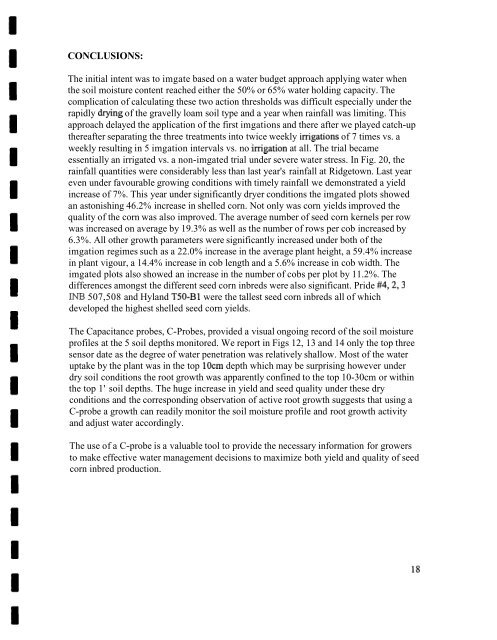ontario sugar beet growers - Atrium - University of Guelph
ontario sugar beet growers - Atrium - University of Guelph
ontario sugar beet growers - Atrium - University of Guelph
You also want an ePaper? Increase the reach of your titles
YUMPU automatically turns print PDFs into web optimized ePapers that Google loves.
CONCLUSIONS:<br />
The initial intent was to imgate based on a water budget approach applying water when<br />
the soil moisture content reached either the 50% or 65% water holding capacity. The<br />
complication <strong>of</strong> calculating these two action thresholds was difficult especially under the<br />
rapidly dryng <strong>of</strong> the gravelly loam soil type and a year when rainfall was limiting. This<br />
approach delayed the application <strong>of</strong> the first imgations and there after we played catch-up<br />
thereafter separating the three treatments into twice weekly imgations <strong>of</strong> 7 times vs. a<br />
weekly resulting in 5 imgation intervals vs. no irrigation at all. The trial became<br />
essentially an irrigated vs. a non-imgated trial under severe water stress. In Fig. 20, the<br />
rainfall quantities were considerably less than last year's rainfall at Ridgetown. Last year<br />
even under favourable growing conditions with timely rainfall we demonstrated a yield<br />
increase <strong>of</strong> 7%. This year under significantly dryer conditions the imgated plots showed<br />
an astonishing 46.2% increase in shelled corn. Not only was corn yields improved the<br />
quality <strong>of</strong> the corn was also improved. The average number <strong>of</strong> seed corn kernels per row<br />
was increased on average by 19.3% as well as the number <strong>of</strong> rows per cob increased by<br />
6.3%. All other growth parameters were significantly increased under both <strong>of</strong> the<br />
imgation regimes such as a 22.0% increase in the average plant height, a 59.4% increase<br />
in plant vigour, a 14.4% increase in cob length and a 5.6% increase in cob width. The<br />
imgated plots also showed an increase in the number <strong>of</strong> cobs per plot by 11.2%. The<br />
differences amongst the different seed corn inbreds were also significant. Pride #4,2,3<br />
lNl3 507,508 and Hyland T50-B1 were the tallest seed corn inbreds all <strong>of</strong> which<br />
developed the highest shelled seed corn yields.<br />
The Capacitance probes, C-Probes, provided a visual ongoing record <strong>of</strong> the soil moisture<br />
pr<strong>of</strong>iles at the 5 soil depths monitored. We report in Figs 12, 13 and 14 only the top three<br />
sensor date as the degree <strong>of</strong> water penetration was relatively shallow. Most <strong>of</strong> the water<br />
uptake by the plant was in the top 10cm depth which may be surprising however under<br />
dry soil conditions the root growth was apparently confined to the top 10-30cm or within<br />
the top 1' soil depths. The huge increase in yield and seed quality under these dry<br />
conditions and the corresponding observation <strong>of</strong> active root growth suggests that using a<br />
C-probe a growth can readily monitor the soil moisture pr<strong>of</strong>ile and root growth activity<br />
and adjust water accordingly.<br />
The use <strong>of</strong> a C-probe is a valuable tool to provide the necessary information for <strong>growers</strong><br />
to make effective water management decisions to maximize both yield and quality <strong>of</strong> seed<br />
corn inbred production.

















